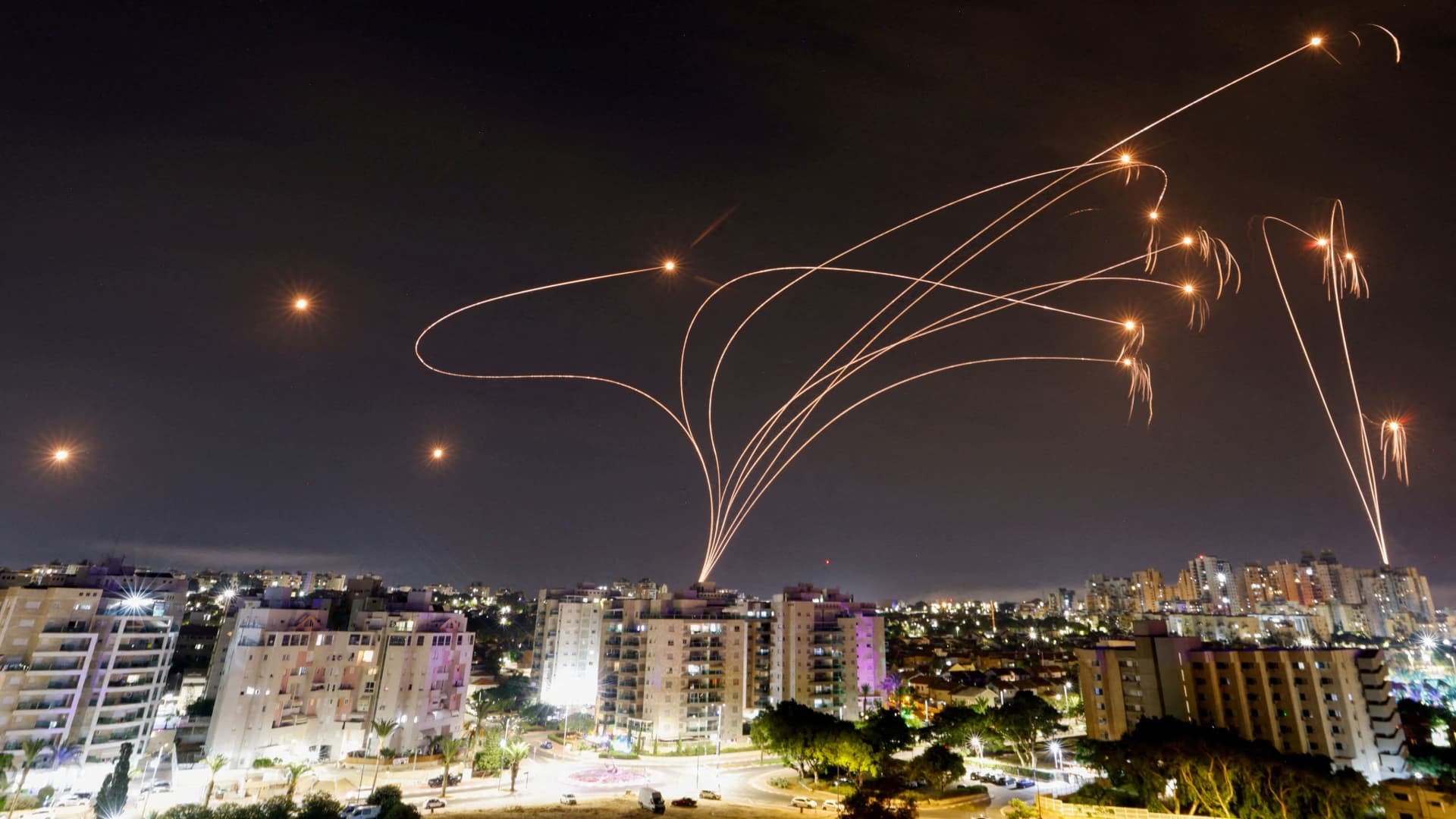Israel’s Iron Dome anti-missile system intercepts rockets launched from the Gaza Strip, as seen from the city of Ashkelon, Israel October 9, 2023.
Amir Cohen | Reuters
Israel is once again relying on its Iron Dome to fend off attacks from the Palestinian militant group Hamas, orchestrating its missile defense system to protect its citizens amid the ongoing conflict.
The strategic importance of the short-range system has been underscored in the wake of a devastating and coordinated assault from Hamas on southern Israel over the weekend.
Israel has responded by pounding Gaza with airstrikes, while the country is expected to launch a ground offensive in the region in the coming days.
Israel has also ordered the “complete siege” of the Gaza Strip, seeking to stop the supply of electricity, food, water and fuel to the already blockaded population of roughly 2.3 million people.
As a result of the persisting violence, at least 1,200 Israelis have been killed, with more than 2,700 injured, according to Israel’s military. Meanwhile, the Palestinian Ministry of Health says 1,203 people in Gaza have been killed, with 5,763 injured.
What is Israel’s Iron Dome?
The Iron Dome, or “Kippat Barzel” in Hebrew, is widely regarded as one of the most important tools in Israel’s arsenal. In part, that’s because it is thought to be highly effective.
Israel’s Defense Ministry claimed the Iron Dome successfully intercepted 97% of all Palestinian rockets fired during one weekend surge of Gaza fighting last year, while the system recorded a 95.6% success rate during a rocket attack by the Palestinian Islamic Jihad in May. The militant group, which seeks the destruction of Israel, has been designated a terrorist organization by Israel, the U.S., the European Union and others.
The mobile all-weather defense system, which became fully operational in March 2011 and has been upgraded several times since, is designed to protect Israeli citizens by launching guided missiles to intercept incoming rockets and other short-range threats in mid-air.
The system has been “tested consistently” since first being put to use in April 2011, Israel’s Defense Ministry says, and “successfully prevented countless rockets from hitting Israeli communities.”
Originally produced in Israel, the Iron Dome was developed by state-owned Rafael Advanced Defense Systems with U.S. backing — and Washington continues to provide funding for it today.
An Iron Dome launcher fires an interceptor missile as rockets are fired from Gaza, in Ashkelon, Israel May 10, 2023.
Amir Cohen | Reuters
Israel’s Defense Forces say the Iron Dome is a compilation of several features: the technology itself, the machinery used to intercept incoming rockets, the soldiers who operate the system and the commanders who supervise the network.
How does it work?
In practice, the Iron Dome uses radar to track incoming rockets and can determine whether the missile’s trajectory poses a threat to a protected area, such as a strategically important site or populated center.
If the rocket does pose a threat, a command and control center can respond by launching its own Tamir missile to intercept it. The system is not configured to fire on rockets outside of a protected area, meaning these are ignored and left to land harmlessly elsewhere.
A Congressional Research Service report published in early March described the Iron Dome as a mobile anti-rocket, anti-mortar and anti-artillery system that can intercept launches from 2.5 to 43 miles away.
It is estimated to have at least 10 batteries deployed nationwide, each of which is designed to defend a 60-square-mile populated area. Each battery is equipped with three to four launchers and each launcher contains up to 20 Tamir interceptors.
The Center for Strategic International Studies, a U.S. think tank, has previously estimated that a complete Iron Dome battery costs roughly $100 million to produce.
Prior to Hamas’ Oct. 7 attack, the U.S. was estimated to have provided nearly $3 billion to Israel for Iron Dome batteries, interceptors, co-production costs and general maintenance. U.S. lawmakers have repeatedly voted in favor of providing funding to Israel’s Iron Dome’s in recent years.
“Thanks to the Iron Dome, we have not sustained tremendous casualties from the rockets that have been fired,” Lt. Col. Jonathan Conricus, a spokesperson for Israel’s Defense Forces, said Saturday in a video statement posted via X, formerly known as Twitter.
At the time of that broadcast, the IDF’s Conricus said the overwhelming majority of the casualties Israel had sustained had been the result of “close-contact fighting” and “cold-blooded killings” of civilians and soldiers.
The Iron Dome has its weaknesses, however, and analysts have warned that the defense system could encounter challenges when responding to heavy rocket fire.
The Center for European Policy Analysis, a U.S. think tank, said in June 2021 that should militants successfully identify and achieve the saturation of Israel’s Iron Dome, “critical updates to the system may not be achievable.”
A saturation attack is designed to overwhelm the Iron Dome shield with simultaneous missile attacks from various directions to impair the system’s ability to sufficiently respond.
